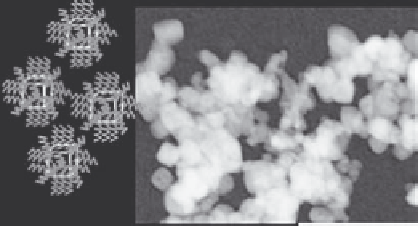Geoscience Reference
In-Depth Information
In(NO
3
)
3
SnO
2
KOH
Water
Hexanoic acid
Heaxane
450°C
30
MPa
100
nm
Figure 10.52 Schematic representation of strategy for indium tin oxide nanoparticles
synthesis.
Source: Photograph courtesy of T. Adschiri.
the surface of the modified nanoparticles. This has been discussed in detail earlier
in Section 10.3.
10.7.3 Mechanism of Formation of Organic
Inorganic
Hybrid Nanoparticles
A knowledge on the mechanism of the formation of organic
inorganic hybrid
nanoparticles is very important and it deals with the interaction of the organic
ligand molecules with the inorganic metal oxide surfaces. Adschiri and coworkers
have worked out, in detail, the theory and mechanism of the hybrid organic
inor-
ganic nanoparticle formation under supercritical hydrothermal conditions.
10.7.4 Self-Assembly of Organic
Inorganic Hybrid Nanoparticles
Self-assembly is a generic term used to describe a process leading to the ordered
arrangement of molecules and small components such as small particles like nanopar-
ticles occurring spontaneously under the influence of certain forces such as chemical
reactions, capillary forces, and electrostatic attraction. Self-assembly and more gener-
ally self-organization of particles in a solvent is considered to be a powerful process
for building patterns up to nanoscopic level through multiple interactions among the
components of the system under consideration. Ordered assemblies of nanometer-
sized particles represent an interesting class of nanomaterials that provide exceptional
potential for a wide variety of applications. These structures would be useful for vari-
ous applications like displays, sensors, data storage, and photonic band gap materials
owing to their exceptional physical, chemical, and electronic properties
[241
244]
.
Common approaches
to noncovalent
assembly strategies
employ van der
Waals
packing interactions, hydrogen bonding, ion pairing, and host
guest inclusion
chemistry
[245
248]
. These self-assembly methods provide direct access to extended
structures from appropriately designed nanoparticle building blocks. The assembly of
nanoparticles from solutions into close-packed monolayers and superlattice structures



